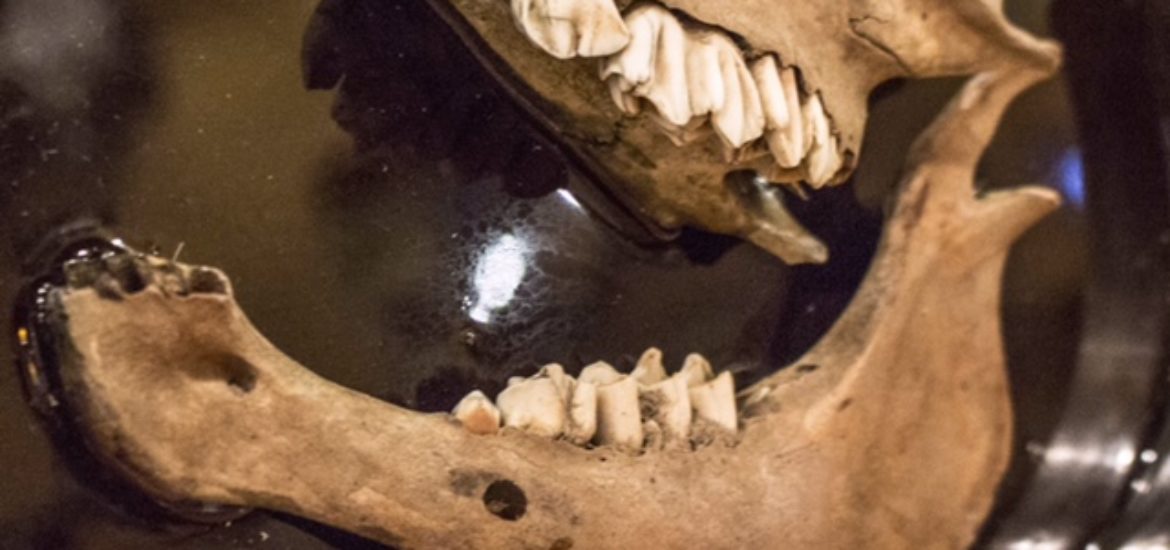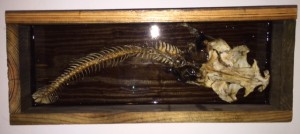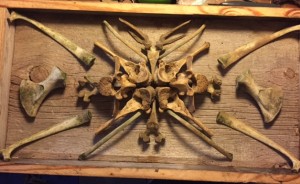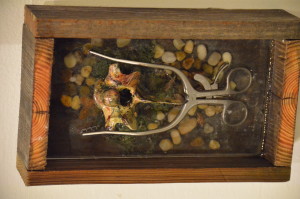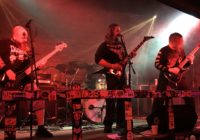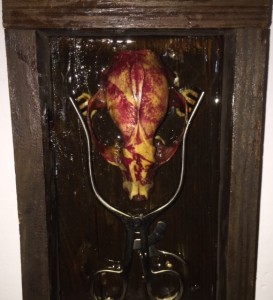 Art is a very subjective, creative medium. Some use paint and pencils, while some use other kinds of materials to create works of art. Though you’ll never see her art in a graveyard, you might see her in the “pet semetary.” After all, they do come back, with her, but only in skeleton form. She could be called the Ed Gein of the post mortem animal planet and the Frankenstein of the animal kingdom so to speak.
Art is a very subjective, creative medium. Some use paint and pencils, while some use other kinds of materials to create works of art. Though you’ll never see her art in a graveyard, you might see her in the “pet semetary.” After all, they do come back, with her, but only in skeleton form. She could be called the Ed Gein of the post mortem animal planet and the Frankenstein of the animal kingdom so to speak.
Vandalia’s Michelle Carr truly takes her bone chilling art, dark inspiration and insidious creativity seriously. She also takes it from mother earth, literary. Inspired by her professional surroundings, horror movies, music and the anatomy, she’s a cross between a modern day Indiana Jones with the decorative tastes of Leatherface. Digging up her personal “treasure” with a small backhoe and spade (tools of the trade), no treasure map or diary needed. No coffins to open, as remains are tossed in the ground. Carr specializes in constructing boxes housing worlds of art one would expect to see in the Sawyer residence with the buzz of chainsaws and screams from the basement.
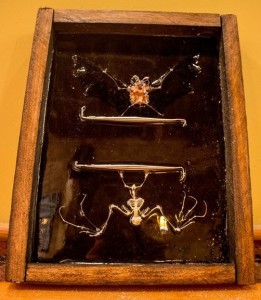 Half of her creations are found in the dirt, dug up and reused, after cleansing. Her unique brand of unearthed creativity involves designs and patterns using dead animal bones and discarded medical tools. The finished products resemble something between Aliens, Predator, Texas Chainsaw Massacre and a Carcass song. Being a repo woman of the animal dead, she’s encased fruit bats, beetles, minks and giant butterflies found online. All used cattle bones have been dug up.
Half of her creations are found in the dirt, dug up and reused, after cleansing. Her unique brand of unearthed creativity involves designs and patterns using dead animal bones and discarded medical tools. The finished products resemble something between Aliens, Predator, Texas Chainsaw Massacre and a Carcass song. Being a repo woman of the animal dead, she’s encased fruit bats, beetles, minks and giant butterflies found online. All used cattle bones have been dug up.
She takes great pride in her version of recycling going to farms and removing buried bones (with permission). She usually doesn’t do ‘fresh resurrections.’ Most bones have been in the ground for a while. Farmers have left deceased bodies chained for the insects and critters, then after it’s been picked ‘literally’ to the bone, she goes and gets it.
She has lots of support from friends who find ‘raw materials’ contributing to her post life creations, also gaining followers on social media. She’s sold 11 pieces after doing only 20 last year.
“I’ve bought a lot of unique taxidermy and dead things online and would love to find a water-snake skeleton to use.”
Honoring family in her own unique way is important as all her creations are made on Grandma’s table.
“I have friends that are farmers or own cattle farms, when one dies, they bury them remembering where, and let me go out with a backhoe and dig them up. I get a lot of my bones that way.”
The first time she had young assistants helping. One of the young girls helping her held up vertebrae and said “Will you art me something with this?”
It’s an acquired taste, some like it, some don’t but she does it for herself. “There’s enough odd, out of the box type people that like it. The majority of those that follow it are my friends.”
Many call it morbid. She calls it collectively unique and enjoys creating artistic displays from death. Every customer and spectator can be assured their looking at the real thing when admiring a skull and bones. Her art brings the worlds of mechanical and natural together into an operating room bringing light to the graveyard and the animals ‘back to life’ through her compositions with life-saving tools connected to bones of another species.
“I gross people out all the time. So many people are totally disturbed by what I do especially people I work with cause they’re in the medical field around blood and guts and don’t understand my obsession with blood and guts and the dead.”
Though her gross out level has a high tolerance for her art, she suffers from other common gross out sights and odors, onions being an odd but major foe. “They’re disgusting and make me vomit.”
Carr’s knowledge of surgery, anatomy and physiology has inspired her creative outlets. It’s not a shock to know she’s been a horror fan since childhood.
Some of her non-anatomical supplies include surgical instruments, repurposed wood, materials from salvage yards, rundown buildings and old wood. The display boxes are all wood, put together with power tools, stained and repurposed. The boxes take 15-20 minutes to make, selected bones are cleaned/sterilized with peroxide, using a multi process poly mix resin to connect the bones with wires, taking 72 hours to a week and a half.
“I paint, stain or sand the box depending how rustic I want it to look. It all varies, my physical time in it, five hours. It could be 18 hours, it depends. The last piece I did was three weeks, three hours every night. It takes a lot to clean bones; it’s not cut and dry. It’s not like I’m gonna go scrub some bones and I’m done. It has to be completely dry with no moisture or the resin won’t dry. Bone marrow, that’s why the animal has to be dead because the mixture won’t get inside the bone and harden. It’s a process of staining, so the wood and bones are completely dry.”
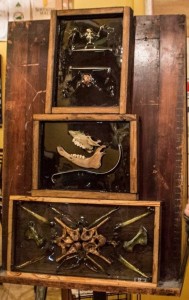 She clarifies that the surgical elements are taken from defective, broken and non-standard instruments. Oddly, amidst the majority of non-traditional aspects, she’s used a most common household product to sculpt part of her displays.
She clarifies that the surgical elements are taken from defective, broken and non-standard instruments. Oddly, amidst the majority of non-traditional aspects, she’s used a most common household product to sculpt part of her displays.
“I’ve sculpted with dryer lint. I made full size zombies out of dryer lint, Paper Mache on a wire frame body. Everything always leans to the dark side.”
One might assume given her medium of choice, death metal and grindcore would be her chosen ear candy but she’s not a fan of inaudible lyrics despite some Carcass tunes being adequate soundtracks to her ‘farm visits.’ Though she loves metal, especially Clutch, she crosses over to Beastie Boys, rockabilly, punk, alternative and jazz. Her first love is classical, making it extra weird, almost darkly comical when she plays Mozart and Beethoven’s greatest pieces while creating her own in the basement surrounded by her personal bone yard. Tiny Tim has also been known to make an audio appearance.
Working with dead remains in her spare time, her dream job is to be a tissue organ harvester. Surgically dismantling bodies, storing parts, tissues and organs for waiting recipients in need. She says there are at least 50 things in the human body salvageable after death. She sees herself as an American Mary of sorts. Donor tissues can be harvested, frozen, transported and thawed for surgery. By day she helps save lives as a surgical assistant, “scrub” with a collection of organized bones ready to mount by night.
2015’s Ladyfest was her first show in years and was a last minute event. This year has been an awakening she says.
Though it’s illegal to sell human bones, if a legal, ethical situation presented itself, she’d be open to using human bone. To her knowledge, her art is a one woman show, never seeing surgical instruments and bones used in a similar vein.
“This kind of came together and became my calling. I always had a fascination with bones and surgical instruments, anatomy itself and my art has always been dark.”
Pieces have grown from 5 inches by 3 inches to a foot to a foot and a half.
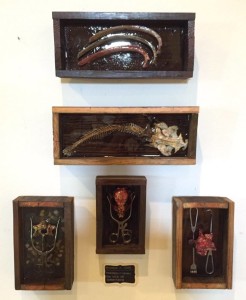 “I’d love to do something big because I have a cow and a half in my basement and I’m ready to harness it together with wire.”
“I’d love to do something big because I have a cow and a half in my basement and I’m ready to harness it together with wire.”
“My winter project is to figure out how to wire an animal together. Wire myself a new creature. In the Texas Chainsaw Massacre all decorative bones were wired together in a similar process.”
She can be found on Facebook at Bone Yard Lust.
She hopes her art will appear at the HorrorHound in Sharonville March 18-20th.
Images by Andrew Kruso

